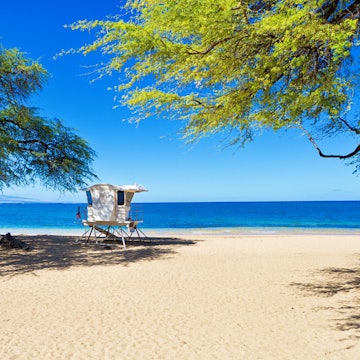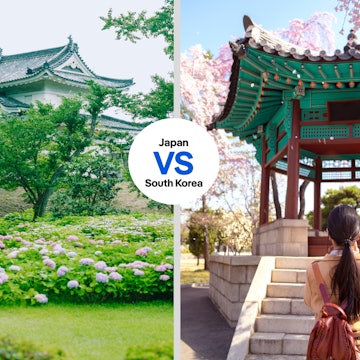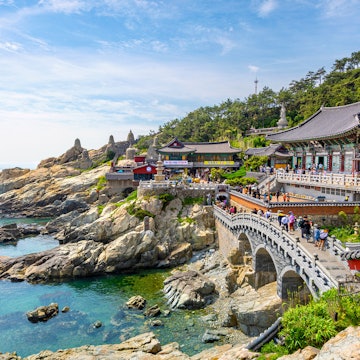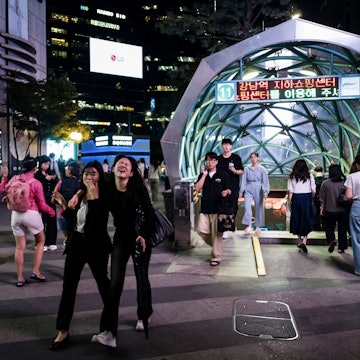

The Jeju Olle Trail. e5can/Shutterstock
South Korea is a frequent character in conversations around the world, thanks to its cutting-edge technology, world-class cuisine, chart-topping pop bands and some of the most exciting movies and TV series being made anywhere.
To this cultural cachet, add in centuries of tradition and copious natural (and manmade) marvels, all in a country of just about 100,000 sq km (38,750 sq miles), and you’ve got one of the planet’s great travel destinations. From dense, dynamic Seoul to the mountainous countryside – remote enough for a rural escape but still accessible via the country's superb infrastructure – South Korea is a truly rewarding place to explore.
Friendly residents are often very willing to help a discombobulated visitor, but these tips can make your trip even easier.
1. Complete your registration three days before you depart
Most travelers – including citizens of the US, Australia and the UK – can visit South Korea visa-free for up to 90 days (up to six months for Canadians). However, you’ll still need to apply for a Korea Electronic Travel Authorization on the K-ETA website at least 72 hours before departure. It’s a simple process, and your K-ETA is valid for two years from the date of approval.
2. Know your accommodation options
Accommodation options in South Korea cater to a wide range of preferences and budgets. Budget travelers can opt for backpacker hostels or guesthouses in major cities and tourist spots, usually with both dormitory and private rooms, often with free internet and breakfast included. For those seeking a unique experience, hanok (wooden homes) guesthouses provide a stay in a traditional Korean-style room with a floor mattress and sometimes communal bathrooms.
More conventional accommodations include hotels, from business to luxury, particularly in urban centers and popular areas like Jeju-do. Adventurous travelers might enjoy glamping near national parks or coastal areas. Alternatively, Templestay offers a cultural and spiritual experience, allowing guests to live like a monk and learn about Buddhist practices in some of the country's most serene settings.

3. Time your visit with the trees
We recommend planning your visit to South Korea for spring or fall, when the peninsula gets its most temperate weather. Bonus points if you can time it to coincide with one of the country’s two periods of arboreal magic. The cherry blossoms start blooming in mid-March on Jeju-do Island, off the south coast, and typically appear in Seoul in early April. In late October and early November, the leaves of ancient ginkgo trees turn into brilliant golden torches, giving Seoul and other cities a particularly regal look for several weeks.
4. Mind these major holidays
The two periods that can cause travelers real problems are the multiday Lunar New Year and Chuseok (fall harvest) holidays. On these two occasions every year, Koreans hit the road en masse, and booking a bus or train ticket is nearly impossible. The dates change each year, so be sure to check when they fall before making travel plans.
If you can’t avoid a holiday, base yourself in a neighborhood in Seoul or Busan for the duration. Plenty of businesses stay open, and the cities can be surprisingly peaceful with everyone out of town.

5. Take advantage of the world-class public transportation system
South Korea’s subways, trains and buses are clean, convenient and efficient. It can sometimes seem like a new station is added to the Seoul metro every month, and the rail and intercity bus networks will take you to every corner of the country. Public transportation is cheap: bus and subway fares in Seoul start at around ₩1000 (less than US$1). In all of South Korea, Jeju-do is the only place where renting a car might make sense, and even there it’s probably not necessary.
With plentiful English information and sensible design, public transportation in South Korea makes getting from here to there a breeze. To get moving, start by picking up a Tmoney transit card at a convenience store or from a vending machine in any subway station. Separate kiosks can be used to load money onto your card. Tap your card both when you board and get off the subway or bus. Fares are calculated by distance, so if you forget to tap when disembarking, you’ll be charged more and won’t be able to transfer for free. You can also use Tmoney cards in most taxis.
When traveling longer distances, it’s simple enough to just buy intercity bus or train tickets at stations. For the high-speed KTX train and some of the more popular routes and times – departing Seoul on Saturday morning, for example – it’s a good idea to purchase in advance. Bus tickets are typically readily available for purchase from machines and counters in bus stations. Buy train tickets on the website of Korail, the national operator.
6. Stay connected with these essential apps
Wi-fi is so prevalent in Korean cities that you can do without a local SIM card, but if you decide that you want one just in case, or if you plan to head to rural areas, the easiest place to pick one up is at one of the many telecom roaming centers at Incheon Airport upon arrival. If you can't be bothered to get one in a store, you can buy a Korean eSIM if your phone supports it. Phone rental is also available in South Korea.
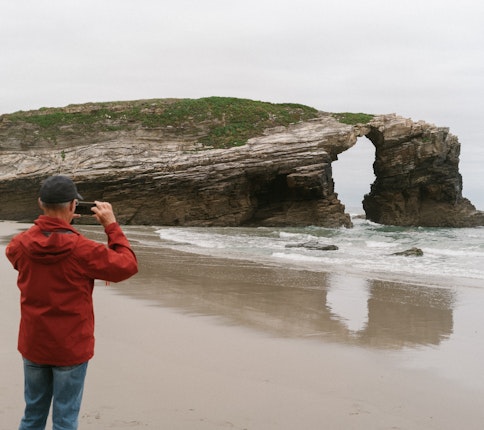
The best way to stay connected.
Saily provides a hassle-free solution to travel data — just choose your data plan and prepare for your trip. When you get to your destination, you can go online right away.
Get your eSIMHelpful apps to download include Naver Map (for iOS and Android), which works better than Google Maps in South Korea; Subway Korea (for iOS and Android) for navigating cities’ metro systems; and Kakao T (for iOS and Android) for taxis.

7. Get out of town
There are two Koreas. We don’t mean North and South, but rather Seoul and everything else – or a bit more broadly, urban Korea and rural Korea. The country has a reputation for being a hyperpaced, highly wired pop-culture dynamo, but its hinterlands present a much different picture, and you’d be missing out big time if you skip them.
The Korean countryside is beautiful. Mountains and rivers make for stunning vistas, and the well-maintained roads are perfect for road trips. Life is lived differently here than in the cities. The population is older – most people under 40 have decamped to the cities – and the pace is slower. At least once on your trip, get out of the urban areas and immerse yourself in this more traditional side of the country.
8. Learn your ga, na, da, ra, ma, bas
Basic English is widely understood in South Korea by people under 50, and signage is almost always in both Korean and English. Yet it’s still a good (and respectful) idea to learn a bit of the language.
Beyond memorizing a few essential Korean words and phrases, learning hangeul, the Korean alphabet, is like gaining access to a secret bonus level of Korean travel. If you can sound out the letters, you’ll find that you already know what things like 카페 모카 (pronounced "ka-pe mo-ka," or cafe mocha), 비빔밥 (bibimbap, a rice dish) and 사우나 ("sa-oo-na," or sauna) are.
Hangeul is easy to learn. King Sejong the Great, who oversaw its creation in the 15th century, declared that a wise man could pick it up before noon and even an idiot could learn it in 10 days. Let’s Learn Hangul teaches the Korean alphabet in an interactive, easy-to-follow way.
9. Be ready to get personal
The typical greeting in South Korea is a quick bow – nothing dramatic, just a head nod deep enough for your gaze to meet the floor – but you’ll sometimes be offered a handshake instead. If you are, expect more of a gentle clasp than the old squeeze and pump.
You’ll likely be asked questions more personal than you’re accustomed to from someone you just met. At the top of this list is your age. This data point is essential to Koreans, as it informs how they talk to one another: how formal their verb endings should be and whether to use honorifics. Inquiries about marital status, occupation and your opinion of South Korea are also common. Answer politely, and feel free to return the question.

10. Roll with the nudges
Koreans live life in a hurry, and they do so in a densely populated country, so you shouldn’t expect the same sense of personal space or public courtesies you find in your home country. Koreans won’t hold doors open for you or apologize if they bump into you when walking. When getting on or off the subway, they likely won’t say, “Excuse me” – they’ll just nudge you aside.
They’re not being rude, though. When you live in a city as crowded as Seoul, it’s just not practical to say sorry every time you knock shoulders with someone – you’d be apologizing constantly. This can be maddening to outsiders, but just accept it and roll with the nudges.
11. Wear what you like, but don’t pack anything too risqué
As a traveler, you can feel free to dress for the weather and comfort. Koreans are pretty relaxed about attire, even if they’re more modest than you might expect. If visiting a temple, while shorts are fine, tank tops and miniskirts are not. Both men and women frequently wear t-shirts at the beach (though it’s best to leave the Speedo or thong at home). Korean women almost never wear low-cut tops, and female travelers could find that doing so brings unwelcome looks. Tattoos are now common among young people, yet some bathhouses will still deny entry if you show any ink.

12. You might have to be flexible about your diet
If you have food allergies or a specific diet, you may have a hard time finding places to eat or getting clear information about ingredients. Vegetarianism and veganism are slowly gaining popularity in South Korea, but not many restaurants cater to these diets. Even dishes that you might think are vegetarian are often made with anchovy broth or fermented shrimp. Common dishes that are vegetarian or vegan include bibimbap (without meat), japchae (sweet potato noodles) and chaeso jeon (vegetable pancake). Buddhist temples often serve vegan food. In Seoul, Bongeun-sa temple serves a vegetarian lunch, and Balwoo Gongyang and Sanchon are restaurants specializing in vegetarian temple food.
13. Eat with others and don’t be afraid to shout for service
Eating is a communal activity in South Korea, and many restaurants, especially barbecue joints, don’t offer single servings. So if you’re traveling solo, you might either have to drag someone from your hostel along with you (not a tough sell) or loosen your belt and order pork belly for two (you poor thing).
At restaurants, servers won’t come check up on you, and most places have call buttons on each table. Give it a push and someone will be right over. Otherwise, to grab the waitstaff’s attention, raise your hand and shout, “Yogiyo!” (Over here!). Water is usually self-service and occasionally side dishes are too. If your server doesn’t set a bottle of water on your table, look around for a water dispenser and stacks of metal cups. At the end of your meal, take the check to the front counter to pay. There’s no tipping. Some traditional restaurants where patrons sit on the floor might require you to remove your shoes before entering.
More restaurant etiquette
Chopsticks: Don't stick your chopsticks upright in a bowl of rice or pass food from one pair of chopsticks to another.
Eating with your fingers: Don’t touch food with your fingers, except when handling ssam (lettuce leaves).
Filling your own glass (with alcohol): Dining companions usually pour drinks for each other – never for themselves. It’s polite to use both hands when pouring or receiving a drink.

14. Get to know Korean drinking culture
The practice of hoesik – a gathering of people, often work colleagues, to go eat and drink together – is common. Drinking, and drinking heavily, is the mainstay of Korean socializing, and an evening out can quickly turn into a blur of barhopping.
The most common drink of choice is soju. The stuff is, more often than not, ethanol mixed with water and flavoring. Drinking too much of it can leave you with a killer hangover. Be especially careful about the infamous "soju bombs," when a shot glass of soju is dropped into a glass of beer and the two are drunk together.
Helping soak up some of that alcohol will be anju (bar snacks; obligatory in some bars). These are likely to be heaped plates of oil-soaked food – French fries, vegetable twigim (fritters) or fried chicken. There's even a word for such a combo: chimaek, from Korean chikin (fried chicken) and maekju (beer).
As in other countries, there's a changing attitude toward excessive alcohol consumption, particularly among young people. An evening spent in a fancy coffee shop or bakery cafe is the norm for nonalcohol drinkers, while those who are looking for cheap drinks, hang out at convenience stores, some of which provide tables for customers to sit down to immediately eat and drink their purchases.
15. Is North Korea a concern?
Despite international headlines, South Koreans don’t worry about an attack from North Korea – and neither should you. Military clashes are very rare, and danger to civilians is rarer still. A guided tour to the DMZ can be a fascinating and truly nowhere-else experience: when you’re looking at South Korean soldiers looking at North Korean soldiers looking at you, the geopolitical stakes hit differently. Plus, many tours offer what may be your only chance to actually step foot in the world’s most secretive country.

16. Monitor the air quality
Even in postpandemic times, it’s a good idea to always carry a mask, as air quality can occasionally drop to pretty nasty levels. This is especially true in spring, when dust blown off the deserts of Mongolia and northern China combines with local pollution to create unhealthy air. Download an app like IQAir Air Visual (for iOS or Android) to keep track of current conditions and the upcoming forecast across the country.
17. Recognize that LGBTIQ+ acceptance still has a long way to go
While attitudes are slowly changing, South Korea remains a conservative society in many respects, and anti-LGBTIQ+ prejudice is common. Even so, LGBTIQ+ travelers are more likely to be on the receiving end of curious – if misinformed – questions than any sort of open hostility. Public displays of affection are generally frowned upon (this goes for straight couples too).
Seoul has small gay districts in Itaweon and Jongno-3-ga, while the Hongdae-Sinchon-Ewha university corridor is another place where LGBTIQ+ Koreans feel comfortable being themselves.
18. Use common sense and keep these numbers handy, just in case
Theft and violent crime are rare in South Korea. Scams and pickpockets targeting travelers are virtually nonexistent, and Koreans typically go out of their way to be hospitable to visitors. Nonetheless – as anyone should anywhere – exercise basic caution and common sense. South Korea has strict drug laws, and don’t even think about trying to sneak past them. Nightlife often revolves around heavy drinking, so know your limit to avoid putting yourself in a sketchy situation.
If you do have an emergency, call 112 to reach the police, 119 for emergency services or 1330 to reach the Korea Travel Hotline, where an operator will connect you to the appropriate service and serve as an interpreter. That number can also be used to reach the Korea Tourist Police.








